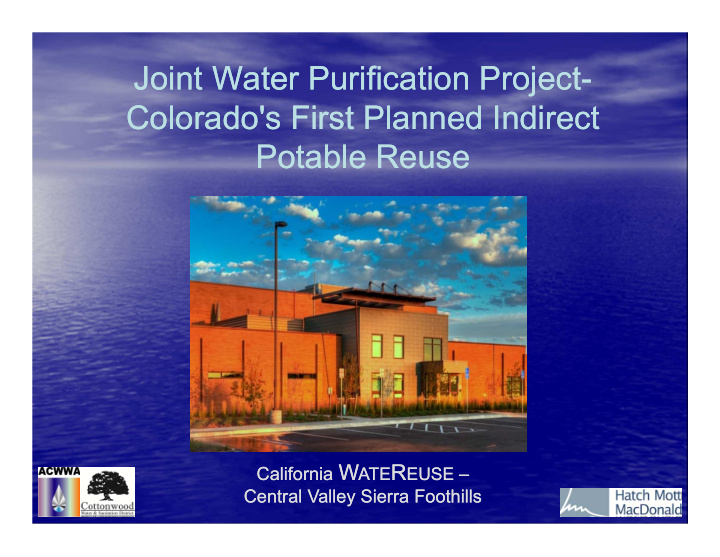



Joint Water Purification Project- Joint Water Purification Project- Colorado's First Planned Indirect Colorado's First Planned Indirect Potable Reuse Potable Reuse April 25, 2013 April 25, 2013 California W ATE R EUSE – California W ATE R EUSE – Central Valley Sierra Foothills Central Valley Sierra Foothills
Project Overview Project Overview • Joint venture with two owners: – Arapahoe County W&WW Authority (ACWWA) – Cottonwood W&S District (CWSD) • Location – Southeast Denver metro area • System Capacity – Initial= 9 mgd – Build out= 12 mgd
Water Supply Sources Water Supply Sources • Sources – Non-renewable deep aquifer sources – Renewable Cherry Creek alluvial water • The renewable alluvial water has several water quality issues: – High percentage of effluent form upstream WWTPs – ( ≈ 60% current, up to ≈ 80% in the future) – Emerging contaminants of concern Cherry Creek and a typical alluvial well house – Aesthetics (Iron, color, hydrogen sulfide) – Uranium and radon gas
Alluvial / Indirect Potable Reuse Alluvial / Indirect Potable Reuse Water Quality Issues Water Quality Issues Microbial Re-growth in Wastewater Water Quality Concerns
Project Goals Project Goals • Original Project Goals: – Provide treatment for the alluvial water supply, thereby protecting its long term usability – Long-term implementation of Indirect Potable Reuse to the extent possible – Provide an appropriate level of treatment that would have public support – Maximize use of renewable alluvial supply – Address aesthetic concerns → Many of these are policy level decisions
Key Components of the Indirect Key Components of the Indirect Potable Reuse System Potable Reuse System • Expansion and upgrades to the Lone Tree Creek Water Reclamation Facility (LTCWRF) • Development of a Raw Water Delivery system that provided 6 months of travel time The LTCWRF, which includes • Development of a water tertiary treatment/ filtration, treatment facility and was placed into operation associated waste stream August 2009 treatment processes
Overall System Configuration Overall System Configuration Alluvial Recharge Park/ Greenbelt Potable Irrigation Water Use JWPP WTP Dedicated Alluvial Wells Water Treatment Waste Discharges to Sewer Deep Brine Dedicated Aquifer Alluvial Treatment Wells Wells Wastewater Treatment Brine to Discharge
Project Timeline Project Initiation JWPP WTP Pre-Design Complete LTCWRF Pre-Design Complete LTCWRF Design Complete LTCWRF Construction Begins JWPP WTP Design Complete JWPP WTP Construction Begins LTCWRF Construction Complete JWPP Producing Water 2003 July Sept Jan June Oct Feb Aug June 2005 2005 2006 2006 2007 2008 2009 2010
Project Development Project Development • Developed a Technical Advisory Committee (TAC) • Hired a Public Relations firm to assist with developing the message • Evaluation & comparison to CA Indirect Potable Reuse Systems, site visits • Implementation of multiple barrier concepts • Progress design meetings with Colorado Dept of Public Health and Environment • Presentations to engineering community • Public participation and presentations • Value Engineering during design
Technical and Institutional Issues Technical and Institutional Issues • Development in a high end commercial park • Fouling of RO membranes due to wastewater colloidal particles • Treatment of RO brine to remove phosphorus and other permit requirements • Impacts of waste streams to the sewer system • Accumulation of salts in the alluvium due to RO brine discharge • Challenges in developing the raw water system, including yield and locating wells with acceptable water quality for membranes Significant capital and O&M costs are realized for the RO brine treatment system
Comparison of System Comparison of System Configurations Configurations Advanced Advanced Customers Wastewater Water Treatment Treatment Alluvial/Aquifer Discharge and Treatment California IPR Systems Advanced Customers Advanced Water Treatment Wastewater Treatment Alluvial/Aquifer ACWWA/CWSD have Discharge and little control over Treatment other WW discharges and urban runoff Joint Water Purification Project
Potable Treatment Configuration Potable Treatment Configuration Water Quality Monitoring RO Skids Oxidation Air Reactors Strippers (UV/H2O2) Clearwell/ Alluvial Disinfection Filtration/ Advanced 6 month Wastewater Travel Time Treatment
Plant Multiple Barrier Concepts Plant Multiple Barrier Concepts TREATMENT CONTAMINANTS OF CONCERN PROCESS Pathogens/ Inorganic Radionuclides Organics Microbial TOC VOC/SOC Emerging Alluvial X 1 X 1 X 1 X 1 Filtration Reverse X X X 2 X X 3 X 3 Osmosis Advanced X X Oxidation Air Strippers X 4 X 5 Chemical X Disinfection 1. Will generally remove organics except volatiles with MW < 200-300 2. Will remove radionuclides with the exception of radon gas 3. Will remove light volatile organics 4. Will remove radon gas only
Construction Cost Summary Construction Cost Summary ITEM COST Bid Package 1- $27,500,000 Water Treatment Plant Potable Treatment Processes $23,000,000 Concentrate Treatment System $4,500,000 Bid Package 2- $3,500,000 Pipelines Bid Package 3- $2,000,000 Raw Water Supply Wells TOTAL $33,000,000
Questions and Answer Questions and Answer
Recommend
More recommend